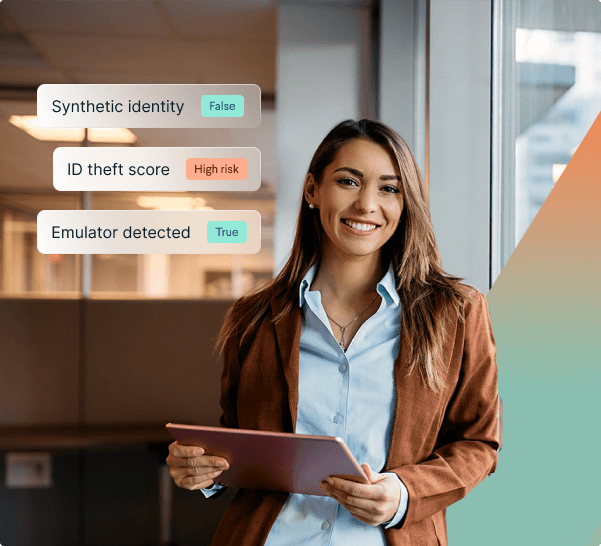How to Create a Know Your Customer Checklist | SmartSearch
By SmartSearch

If you’re a financial institution, it’s your responsibility to do everything in your power to prevent money laundering, fraud and financial crime. Part of the fight against this crime is the Know Your Customer process, which is a compulsory part of AML checks. This process is all about verifying identities during onboarding, and it’s essential that every element of the KYC checks is covered to protect your company and other organisations.
In this blog, we’ll walk you through how to create an effective Know Your Customer checklist that covers everything required during these checks, from ongoing monitoring to Customer Due Diligence.
To ensure safety and compliance, utilise our Know Your Customer software at SmartSearch. We cover everything in this checklist to maximise security and streamline onboarding.
What does KYC entail?
Know Your Customer involves policies used by financial organisations to verify the authenticity of customers and their funds.
KYC acts to:
- Assess the customer and any potential risks
- Monitor customers' transactions and behaviour
- Collect and maintain customer records
KYC checks are designed to prevent financial crime and protect your business from money laundering.
There are three main processes that go into a know your customer checklist.
- AML Checks
- Customer Due Diligence
- Ongoing Monitoring
Now that you’re aware of what goes into KYC checks, let's dive into a detailed checklist of each step.
Step 1: AML Checks
Anti-money laundering checks are the first stage in verifying customers. During the AML process, your AML officer will need to check:
- Customers' legal names and date of birth
- Government IDs - Passport, driver's license
- Proof of address - Bank statements, utility bills
Utilising document verification software will ensure the legitimacy of customer documents. When submitting documents through this software, computers can identify falsified information and screen photos against live images of customers to verify identity.
When onboarding businesses, these checks also need to include:
- Business registration details
- Registered address
- Ultimate Beneficial Owner details
Once these first steps of the KYC checklist have been completed, you’ll be able to create customer profiles that can be used to check suspicious activity. This is where PEP screening comes into play.
Step 2: PEP Screening and Sanction Checks
Now that the basic steps and customer profile have been established, you can perform PEP screening and sanction checks on your customers.
These checks are designed to help identify customers at higher risk of financial crime. PEPs or Politically Exposed Persons are individuals who are prominent figures to access large amounts of funds. This can include politicians, executives or government officials.
Due to their public influence or access to public funds, any PEP transactions are deemed higher risk. This can also extend to family members associated with PEPs.
What are sanction lists?
In order to prevent businesses from engaging in illegal or high-risk activities, sanction lists are created and updated by national and international authorities. The Foreign Office, the European Union and financial institutions all across the world register individuals, businesses or countries on these lists to help prevent illegal activity.
Adding PEP and sanction checks to your checklist
PEP screening and sanction checks are an essential part of your know your customer checklist, and failing to screen customers against sanctions can result in consequences, including fines and even legal action. These checks should include:
- Manual checks by AML officers alongside automated screening against PEP and sanction databases.
- Identify high-risk individuals based on relationships, countries and political positions.
- Report any findings of high-risk individuals to the correct authorities and document findings.
By screening customers early in the onboarding process, not only do you protect your business from risk, but you also ensure you’re complying with compulsory regulations.
Step 3: Customer Due Diligence
Alongside more enhanced due diligence like PEP screening, you also need to conduct assessments of customer behaviour and transactions as part of your KYC checks. Here’s what to access when conducting Customer Due Diligence:
- Customer intent: Establish why a customer is opening an account or using a financial service. This will help to establish investigations needed and spot any red flags down the line.
- Source of funds: A source of funds check determines where your customers' money comes from. This is established through documents like payslips and bank statements and is used to determine if funds come from legitimate sources.
- Conduct a risk assessment: Establish a risk scoring for each customer from low to high. Document and record any findings to establish the level of ongoing monitoring and further investigation needed.
If a customer has been determined as high risk, Enhanced Due Diligence is required, where further checks are needed, including:
- Source of wealth checks for individuals with high net worth
- Detailed background and legal database checks
- Assessment of business ownership and individuals with authority
- Schedule regular monitoring and frequent reviews
- Physical assessments of business premises
Step 4: Ongoing Monitoring
One of the most important and sometimes overlooked aspects of KYC is ongoing monitoring. Money laundering risks can arise or change at any time, and new sanctions and suspicious transactions can occur at any time.
Your ongoing monitoring checklist should cover:
- Large transaction monitoring and automatic flagging of transactions exceeding the threshold of £10,000.
- Transactions to or from high-risk countries and jurisdictions.
- Frequent, small and regular/structured payments.
Any of these alerts found during ongoing monitoring should be escalated to the appropriate authorities. If suspicious activity is confirmed, your AML officer will be required to submit a Suspicious Activity Report.
Implementing KYC checklists
Once you’ve established a know your customer checklist, it’s time to implement this into your AML processes.
Utilise technology
Using AML technology can save your company time and resources by conducting automated checks alongside your own manual checks.
- Software like TripleCheck speeds up the onboarding process and verifies digital ID and documents in a matter of minutes.
- Facial recognition technology can confirm the identity of individuals on given ID documents.
- Automated screening tools like SmartDoc can scan PEP and sanction lists and flag any matches automatically.
- Ongoing monitoring platforms can detect anomalies in transactions and customer behaviour.
Train teams on KYC compliance
To reduce the risk of human error and ensure all employees are on top of compliance, training is an essential part of your KYC checklist. Your AML officers and staff need to be aware of:
- How to spot suspicious activity and interpret risk
- How to conduct Enhanced Due Diligence and trigger escalations
- Interpreting documents and verifying identities
- New regulations, compliance procedures and trends in financial crime
As regulations and AML procedures begin to evolve and change, so should your checklist. Review your KYC and AML processes annually or alongside the introduction of new legislation. This will help to ensure your processes are refined and strengthened to fight new forms of financial crime.
Ensure full compliance with a comprehensive KYC checklist
The right KYC checklist covers all compliance procedures and helps to keep your business protected against fraud and detect suspicious activity before this becomes a threat. Covering every element of CDD and ongoing monitoring, and staying updated on regulation and new threats, is your best line of defence against the threat of financial crime.
If you need advice on how to strengthen your AML processes or are looking for all-inclusive AML software, get in touch with our team at SmartSearch. You can request a free demo and discover how our comprehensive technology keeps you safe against money laundering.
See it in action
Ac cras tristique malesuada odio porta orci sollicitudin. Magna nisl vitae ut tincidunt sit ipsum at aenean. A hendrerit nec purus accumsan enim.
